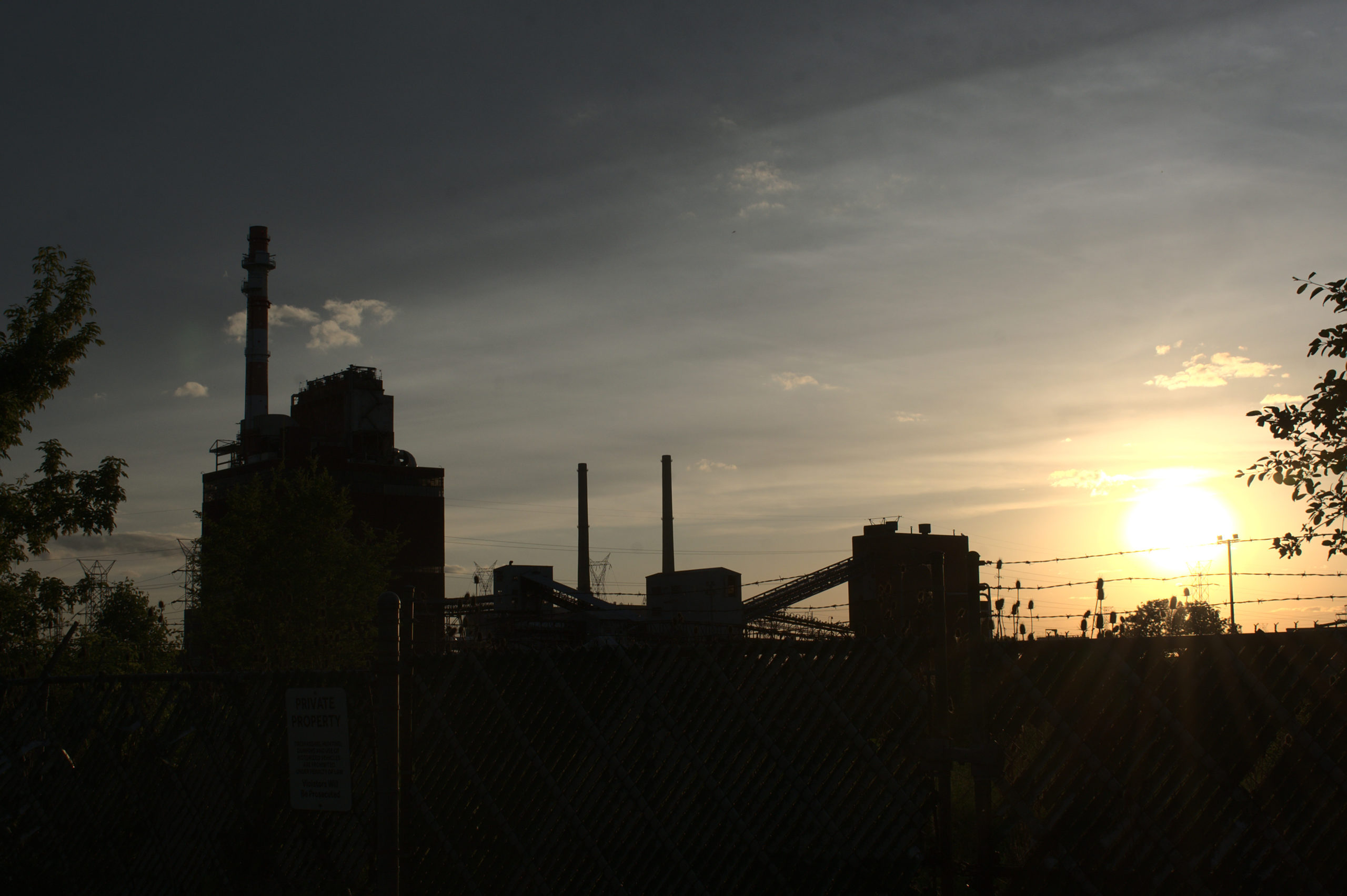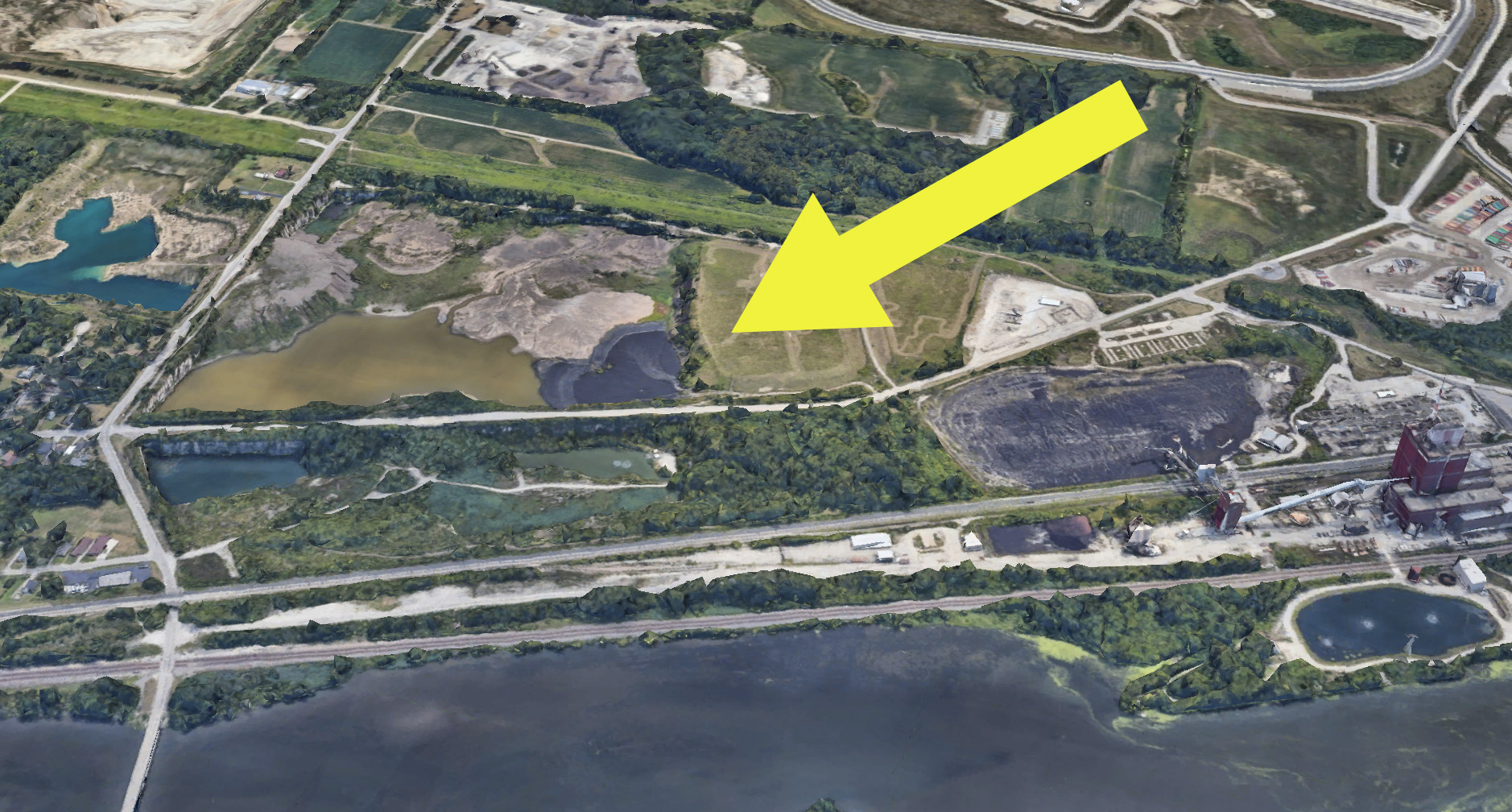
Joliet, Illinois, a city of about 150,000 people southwest of Chicago, has long depended on a deep sandstone aquifer for drinking water – an increasingly strained resource that city officials hope to supplement with a billion-dollar pipeline from Lake Michigan.
But while this highly publicized search for a new source of municipal water unfolds, some residents who rely on private well water face a different threat.
Tucked behind a chain-link fence and shrouded by sprawling, overgrown vegetation is a former limestone quarry holding over six million tons of coal ash – a toxic byproduct of burning coal to generate electricity. Midwest Generation parent company NRG Energy is now in the process of closing the coal ash repository, and plans to do it in a way that experts fear could leave well water at risk into the future.
In 2016, NRG’s nearby coal plants were converted to burn natural gas, but the coal ash accumulated over decades remains.
At hundreds of sites nationwide, coal ash sits in such unlined pits, in most cases contaminating groundwater, according to a 2019 analysis of company data by the Environmental Integrity Project and Earthjustice.
In January, the EPA announced its intent to enforce 2015 federal coal ash rules requiring coal ash pits to safely close and remediate contamination. NRG has proposed capping the quarry and leaving the ash in place, a closure method environmental groups say is dangerous — especially since NRG relies on pumps to keep contaminated groundwater from flowing toward homes and private wells.
The groundwater connected to the quarry is separate from the deep aquifer that the city taps for its water. But environmental lawyers and many residents want NRG to remove the ash entirely and transport it to a landfill, as they have expressed in interviews and public meetings.
NRG disagrees. “We did not hear residents of Joliet say that they preferred excavation and removal,” said NRG spokesperson Dave Schrader, in an email. “In fact, the Will County Environmental Network stated: ‘The Network believes that covering and maintaining the system design would be the best solution for the closure of this facility. We would be opposed to the removal of the ash for several reasons.’”
Excavation and removal would require years of trucking, pollute the air and disturb neighborhoods, NRG said.
Earthjustice attorneys say it is particularly ironic that a company is allowed to potentially put people’s water supply at risk even as the city as a whole fights for a new source of clean water.
“Groundwater is precious. And for folks who want to be able to continue to have the groundwater as a resource, as these folks who depend on their groundwater wells… it is critical that that water be as clean as possible,” said Earthjustice senior attorney Jenny Cassel. “Our groundwater is a limited resource and we’ve got a lot of people and not everybody can drink from Lake Michigan… If folks can’t drink that groundwater anymore, because it’s too contaminated, then that limits the supply.”
Environmental and health concerns
Though Lincoln Stone Quarry is as wide as 90 football fields, many locals are still unaware of it.
Joliet native Jonathan Flint lives a mile from the quarry. Flint moved away in his early childhood before returning to Joliet at age 10. Now 34, he rents a modest one-story home with his wife and five young kids.
Growing up, Flint was aware of the coal plants in town — his father knew people who worked there. But he said he had “no idea” about the quarry.
“I didn’t know what they did over there, honestly,” Flint said. He is a tenant, so he’s unsure if his water comes from a well but many homes in his neighborhood rely on well water. In the past, environmental groups have found elevated levels of toxic heavy metals in private wells they tested near the quarry.
“I hope that they can do something where it doesn’t affect kids 10, 15 years from now,” Flint said.
Since the early 1960s, Lincoln Stone Quarry — a former limestone quarry — was used to dump coal ash from two power plants on the Des Plaines River, owned by the utility ComEd and then Midwest Generation before NRG acquired them as part of a larger fleet in 2013.
Today, the quarry is no longer receiving ash, but the sprawling pit is filled with material from years past. Cassel calls the porous limestone pit a “poster child” for the nation’s coal ash problem.
In addition to being unlined, the quarry’s bedrock is replete with fractures, left over from blasting from mining operations. The local water table also sits above the bottom of the quarry, which plunges dozens of feet deep, meaning coal ash is in constant contact with groundwater.
Midwest Generation installed groundwater monitoring wells around the perimeter of the pit. Since late 2017, pollutants have been detected in all 10 wells. Arsenic exceeded safe levels recommended by the EPA by over 39 times, molybdenum by 36 times and boron by 10 times, according to a 2021 report filed by NRG, as required by the federal coal ash rules.
Schrader said by email that “multiple rounds of sampling of private wells to the east and south of the Quarry has shown that none of the private wells are affected by the Quarry operations,” citing sampling done about 15 years ago.
While NRG says the contaminants have not migrated to residents’ drinking water, environmentalists think there is reason to be concerned. Environmental groups say the 2006 sampling, which found exceedances of boron in private wells, led to Midwest Generation digging deeper wells for some residents. NRG said it installed deeper wells “proactively” after identifying that a neighboring industrial operation was pulling water from the quarry.
In 2010, testing of at least 18 private wells from residential homes just south of the quarry found elevated levels of arsenic, barium and copper, according to a report commissioned by the Environmental Integrity Project, Earthjustice and the Sierra Club.
Victor Franchi has lived in Rockdale, in that area of homes, for the past two and a half years and knows about the coal ash issue. He said he wants NRG to test his well water. Rodolfo Mendoza, 26, lives with his parents next door. Born in Mexico, he moved south of the quarry from Joliet two years ago. He was unaware of nearby coal ash but said his family buys five-gallon water jugs from Walmart every week instead of drinking tap water from their well.
Environmental groups were also concerned that pumping of a nearby quarry would alter the local hydrology and pull contaminants further down into the groundwater and toward residential homes. As a result, Midwest Generation installed extraction wells along the quarry between 2009 and 2012 to draw the contamination away from homes. According to NRG, the wells create a cone of depression where water is intercepted and pumped back toward the quarry.
The wells “ensure that the groundwater flows towards the LSQ, mitigating any potential impacts offsite,” said Schrader.
But Cassel said the system is “not fully working,” pointing to instances in which wells have been plugged and contamination has moved off-site.
“It’s not so much that the extraction wells in themself are a concern,” said Cassel. “It’s the fact that Midwest (Generation) is to any degree relying on those extraction wells to stop the contamination going off site when the evidence has shown that they don’t appear to be working.”
The extraction wells act like straws, “sucking the groundwater up so that it doesn’t spread off the site,” said Faith Bugel, an attorney representing the Sierra Club. “The whole solution is simply a big straw that keeps the contamination on site. That’s not a permanent solution. That’s not a long-term solution.”
The company believes the system is successfully diverting the contaminants, but activists say without proper testing, drinking water is still at risk. Well testing can be expensive — a luxury low-income residents may not be able to afford.
Sandy Burcenski, founding director of environmental group Citizens Against Ruining the Environment (CARE), said she worries most about the state of local private wells. The Lincoln Stone Quarry is like a toxic “stew” to her.
“In my opinion, if you don’t test the wells, how do you know they’re not being impacted?” she asked.
After learning about coal ash at the nearby quarry from an Energy News Network reporter, Flint said he “hope(s) and pray(s)” the contamination never gets to a physically affecting point. In the meantime, Flint says his family will continue drinking store-bought bottled water, like they have done for years. His wife, whom he describes as health-conscious, believes bottled water is safer than the water coming out of their tap.
“I’ll keep drinking bottled water,” Flint said. “I’ll definitely share this with her, and she’ll probably buy an extra case now.”
Residents, environmental groups oppose NRG’s plan

Coal ash at Lincoln Stone Quarry is shrouded by sprawling vegetation. The quarry holds over six million tons of coal ash. (Photo Credit: Sarah Aie)
Ellen Rendulich could long see the Joliet coal plants’ towering smokestacks in the distance from the verdant hills of Lockport, the riverfront city she has lived in for the past three decades.
Rendulich, also a founding director of CARE, first learned about coal ash 22 years ago. Back then, CARE was among environmental groups nationwide fighting for coal ash to be designated a hazardous waste, an effort thwarted in large part by utilities and companies that reuse coal ash in building materials.
Now, Rendulich said they want the contaminating substance to be completely removed from pits like Lincoln Stone Quarry.
“We want them to completely go down to bedrock and clean that quarry up,” she said.
Residents are making similar demands about coal ash sites statewide. At recent public meetings, residents and activists denounced plans proposed by NRG for coal ash at the Powerton coal plant near Peoria — another one of the plants acquired in the 2013 deal — and Vistra Energy for the E.D. Edwards coal plant. The companies plan to close the pits leaving coal ash in place at both sites; residents said the ash should be removed.
Illinois passed its own coal ash regulations in 2019 — among the nation’s strongest state laws governing coal ash. Unlike the federal rules, Illinois’ law covers ash ponds closed before 2015, mandates companies make financial assurances they can handle ash cleanup and requires companies to get public input on their ash pit closure plans.
As a result, NRG was required to submit a new closure application to state regulators for Lincoln Stone Quarry. Despite the state’s more stringent parameters, NRG still proposed to close the quarry leaving ash in place.
“Closure in Place provides both short- and long-term protection to groundwater and surface water resources along with ensuring overall protection to public health, welfare, and safety,” Schrader said.
NRG said removing the ash and trucking it to a landfill would disturb neighborhoods. According to the company’s calculations, the process would take 20 years to complete, with a truck passing by local homes every five to 10 minutes.
Cassel said the problem at Lincoln Stone Quarry is also one of environmental justice in which disproportionately burdened communities bear the brunt of various sources of pollution. The population of people of color in Joliet is higher than the state average. Rockdale, a village of 2,500 that borders the quarry, is 42% Hispanic and majority low-income, according to census data.
“We know this community has already been bombarded with trucks and bombarded with other pollution sources. That’s unfortunately the classic picture of what disproportionately burdened communities have to put up with,” Cassel said. “We think there’s going to be a burden on the community no matter what happens here. We think it has to be removal but we are absolutely trying to advocate with our partners and clients that that removal be done in as safe and considerate and least-polluting way possible.”
Earthjustice associate attorney Hema Lochan said the closure plan “left out important details.”
It used modeling scenarios for closure by removal that were out of date and did not consider any transportation methods other than trucking. It also claimed it could not find a landfill capable of taking all of Lincoln Stone Quarry’s coal ash but did not consider spreading it between several different landfills.
“There (were) many holes in their claim that closure by removal would just take that much money and that much time,” Lochan said.
NRG projects removal would cost upwards of $295 million and take 20 years, whereas closure in place would cost a total of $24 million and take two and a half years. The federal law prohibits companies from citing cost as a factor in their choice of closure method. Schrader said cost was not a factor for NRG.
Advocates point to other sites across the country where removal is under way to show that it is a viable option. Utilities in Virginia, North Carolina and South Carolina are removing hundreds of millions of tons of coal ash from sites, a historic undertaking prompted by state laws and legal settlements.
Next steps: Legislative implications

Lincoln Stone Quarry, middle left, is located less than a mile away from residential homes. NRG has proposed plans to cap the quarry, leaving the ash in place. (Google Earth)
As part of its effort to start enforcing the rules, in January the EPA denied a number of requests for extensions on a deadline to stop putting ash in unlined pits. The move was encouraging, attorneys said, as state regulators may likewise step up enforcement.
Earthjustice attorneys believe that to comply with federal law, NRG must not be allowed to leave coal ash in the quarry. Among other things, they note, it is sitting in groundwater which directly violates federal regulations — something the EPA reaffirmed in its January denials.
“You’ve got millions of tons of coal ash and many, many feet of groundwater. And we know it’s leaching out of there through the cracks in the bedrock,” Cassel said. “Leaving ash in place is not a safe way to close it in place, regardless of what the costs may be.”
In coming months, state regulators will decide whether to approve NRG’s closure plans for Lincoln Stone Quarry. The results may lead to a public comment period or litigation from environmental groups. Hence Joliet’s water future — that of municipal water and private well water — is in the hands of local government and regulatory agencies.
“It’s critical for the folks in Joliet where water is such a precious resource that we make sure that water is left as clean as possible for future generations,” said Cassel.
Catch more news at Great Lakes Now:
In the Finger Lakes, a bitcoin mining plant billed as ‘green’ has a dirty coal ash problem
Cracking down on coal ash: Tough talk and tough choices
Featured image: Joliet 9 Generating Station has dumped coal ash into Lincoln Stone Quarry since the early 1960s. It was converted to natural gas in 2016 and no longer produces coal ash. (Photo Credit: Sarah Aie)




